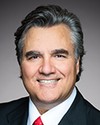Good evening, Mr. Chair and honourable members. I am very glad to be with you in person today to describe high-frequency rail.
My journey from Chatham, Ontario, this morning, took 10 and half hours. If the promises of HFR are kept, that will be six and half—a big difference.
HFR when initially announced was supposed to quickly triage Canada's ability to run trains on time and operate enough trains to meet demand, putting Via Rail Canada back on a sound financial footing and getting it ready to build on that foundation across the country.
Transport Action members and supporters naturally had questions and concerns when this proposal was first unveiled, such as why high-speed trains would not be built as was previously studied. Past governments had balked at those costs, and HFR was supposed to provide most of the benefits.
Would smaller cities face service cuts? Assurances were forthcoming that that wouldn't be the case.
Could the timings be achieved on the proposed Havelock alignment? We later saw data that demonstrated the feasibility.
How would this project compare with upgrading the existing route?
Why diesel when electrification could eliminate all emissions?
Even with dedicated tracks for most of the distance, a passenger rail act was still going to be absolutely vital for the times when there was interaction with freight and to make the rest of the network work.
What about the rest of Canada, such as Calgary to Edmonton, for example?
Finally, would the government study delay and ultimately fail to act as did EcoTrain, ViaFast and every other study in the last 40 years while Canada fell further and further behind its global peers on rail? Eight years later, the last of those fears seems pretty accurate.
Yves Desjardins-Siciliano and his colleagues launched extensive public consultations in 2016. The information provided to Transport Canada included a business plan, ridership and infrastructure studies, all done by Systra. That was checked by international peers and a class 3 estimate was done. HFR was decision-ready by summer of 2018, but our government hesitated. Had it followed its Crown corporation's advice, HFR would already be in the final stages of construction today and would be in service by 2025.
Instead, the JPO was created with the Canada Infrastructure Bank in 2019 with a mandate to de-risk the project and a budget of $71 million. The tasks it was assigned, including further engagement with indigenous communities, do not appear to have been accomplished. Its report wasn't published. Information obtained under an access to information request was in heavily redacted form. What the public has seen wasn't worth $71 million.
In 2021, Minister Alghabra made announcements that indicated HFR was indeed finally going ahead. It looked as though the impact assessment would start that fall. Then we had an election. Things went quiet, and that IA didn't start.
Then on March 9, 2022, came the bombshell. What had been Via Rail Canada's $4-billion project to rebuild about 80 miles of track between Havelock and Glen Tay and to upgrade the rest had been turned into a megaproject with a procurement timeline stretching out towards the end of the decade, in which Via Rail was to be shoved aside and the entire Quebec-Windsor corridor outsourced to a private partner taking on revenue risk over a concession period of 30 or more years. With scope creep potentially driving the cost back to $12 billion, it was more like EcoTrain.
The long-awaited start of procurement should have been cause for celebration. Instead, morale at Via Rail took an absolute body blow from this. Nobody had been warned that it was coming. It is not clear how the rest of Via Rail services across Canada will survive without the corridor as their anchor. Nor is it clear how Via Rail is supposed to grow service to continue meeting demand and fully utilize the new fleet that will be delivered between now and the mid-2030s. The government provided no explanation for this pivot.
The page on procurement models in that JPO report was blacked out. There are some really good reasons I can think of for not doing it. Key factors, the factors that will determine long-term demand in ridership, are completely out of a private partner's control.
Will Canada become a country of 50 million, 60 million or 70 million? What will our immigration policy be in the mid-2060s? Will we get any better at distributing growth across the country, or will we stall as other countries do better than we do at accepting international qualifications? What will our housing policy be?
Cornwall and Brockville, for example, haven't set high targets for new homes, but with the frequent trains to Ottawa and Montreal that they've been promised, they could really grow. Peterborough could become a city of a quarter of a million, but only if other policies make that possible.
With gas tax revenues falling as our cars are electrifying, how are we going to price and subsidize highways? How will other competing modes be regulated? Will European-style competition be brought to the rails as was previously discussed? Asking the private sector to price these unknowable risks rather than the controllable risks of project delivery is illogical. There is a herd of public policy elephants in the room, stomping across the balance sheet. The resulting hefty risk premium will end up being paid by taxpayers and passengers, and if a private partner gets into difficulties, it can leave taxpayers to pick up the bill.
The United Kingdom's experience has been a fiasco, even with shorter time horizons for ridership forecasts. It's also notable that the proponents in the recent phase were only asked to provide a class 5 estimate, so we have gone backwards.
The only justification we've been given for this outsourcing is to import the expertise of Deutsche Bahn or SNCF. We do not need to do that.



